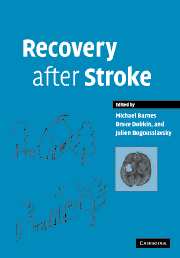Book contents
- Frontmatter
- Contents
- List of authors
- Preface
- 1 Stroke: background, epidemiology, etiology and avoiding recurrence
- 2 Principles of recovery after stroke
- 3 Regenerative ability in the central nervous system
- 4 Cerebral reorganization after sensorimotor stroke
- 5 Some personal lessons from imaging brain in recovery from stroke
- 6 Measurement in stroke: activity and quality of life
- 7 The impact of rehabilitation on stroke outcomes: what is the evidence?
- 8 Is early neurorehabilitation useful?
- 9 Community rehabilitation after stroke: is there no place like home?
- 10 Physical therapy
- 11 Abnormal movements after stroke
- 12 Spasticity and pain after stroke
- 13 Balance disorders and vertigo after stroke: assessment and rehabilitation
- 14 Management of dysphagia after stroke
- 15 Continence and stroke
- 16 Sex and relationships following stroke
- 17 Rehabilitation of visual disorders after stroke
- 18 Aphasia and dysarthria after stroke
- 19 Cognitive recovery after stroke
- 20 Stroke-related dementia
- 21 Depression and fatigue after stroke
- 22 Sleep disorders after stroke
- 23 Technology for recovery after stroke
- 24 Vocational rehabilitation
- 25 A patient's perspective
- Index
23 - Technology for recovery after stroke
Published online by Cambridge University Press: 05 August 2016
- Frontmatter
- Contents
- List of authors
- Preface
- 1 Stroke: background, epidemiology, etiology and avoiding recurrence
- 2 Principles of recovery after stroke
- 3 Regenerative ability in the central nervous system
- 4 Cerebral reorganization after sensorimotor stroke
- 5 Some personal lessons from imaging brain in recovery from stroke
- 6 Measurement in stroke: activity and quality of life
- 7 The impact of rehabilitation on stroke outcomes: what is the evidence?
- 8 Is early neurorehabilitation useful?
- 9 Community rehabilitation after stroke: is there no place like home?
- 10 Physical therapy
- 11 Abnormal movements after stroke
- 12 Spasticity and pain after stroke
- 13 Balance disorders and vertigo after stroke: assessment and rehabilitation
- 14 Management of dysphagia after stroke
- 15 Continence and stroke
- 16 Sex and relationships following stroke
- 17 Rehabilitation of visual disorders after stroke
- 18 Aphasia and dysarthria after stroke
- 19 Cognitive recovery after stroke
- 20 Stroke-related dementia
- 21 Depression and fatigue after stroke
- 22 Sleep disorders after stroke
- 23 Technology for recovery after stroke
- 24 Vocational rehabilitation
- 25 A patient's perspective
- Index
Summary
Introduction
Stroke continues to be the leading cause of disability in the USA and elsewhere, despite the success of preventive strategies. In fact, recent studies have reported an increase in the incidence of stroke (Broderick et al., 1998; Muntner et al., 2002) with close to five million stroke survivors in the USA alone. This trend is likely to continue, driven by many factors, notably increasing life expectancy, aging of the “baby boom” generation, and improved medical treatment to increase stroke survivability. However, 90% of stroke survivors are left with significant impairment and require therapy.
While the number of patients is growing, pressure to contain and reduce the cost of healthcare has grown even faster, prompting a reduction of the time and resources available for post-stroke treatment. This generates a pressing need for new approaches to increase the effectiveness and efficiency of therapy, and one promising approach is to create innovative technology for rehabilitation. In principle, technology may be applied broadly across the entire spectrum of impairments that result fromstroke: cognitive, affective, sensory, andmotor. However,motor deficits persist chronically in about half of stroke survivors (Gresham et al., 1979) and the following will focus on new technology for sensory–motor rehabilitation, in particular on robotic and information technologies.
Rehabilitation robots
In general, there are two broad classes of rehabilitation robot: those directed at recovery, attempting to reduce impairment and restore function, and those directed at compensation for disability. The latter is the older and more mature application. An excellent example is the wheelchair-mounted robot developed in the Netherlands (Verburg et al., 1996). This is an elegant design that can fold unobtrusively when not in use and provides extended reach and limited manipulation to a seated patient.
Though both approaches arguably assist the patient, the term “assistive technology” is traditionally reserved for the direct use of technology to compensate for disability. More recently, attention has turned from such direct assistance to a more indirect role, helping clinicians to help patients recover. Though they present greater technical challenges (see below), robots to aid recovery have the potential for greater positive impact on patients' quality of life. They may be used throughout the process of recovery, beginning before a patient has regained voluntary movement, perhaps even at the bedside; in principle, they may minimize or eliminate the need for assistance.
- Type
- Chapter
- Information
- Recovery after Stroke , pp. 604 - 622Publisher: Cambridge University PressPrint publication year: 2005
- 5
- Cited by



